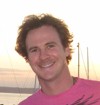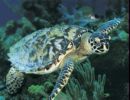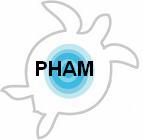Contributors
Ed Armstrong - Jet Propulsion Laboratory
 Ed Armstrong is a senior data engineer and manager in the JPL Physical Oceanography DAAC, a premier data center for oceanographic satellite products. He is a specialist in sea surface temperature measurements and their application in interdisciplinary studies with related ocean color, sea surface height and ocean wind data. He has managed projects for information technology development in support of oceanographic satellite products including value added products such as longterm climatologies and high resolution blended SST. He has over 19 years of experience with satellite remote sensing products and related data for oceanographic research with the last 11 years at the JPL. He obtained a BA in Physics from U.C. Berkeley and a MS in Physical Oceanography from Moss Landing Marine Labs.
Ed Armstrong is a senior data engineer and manager in the JPL Physical Oceanography DAAC, a premier data center for oceanographic satellite products. He is a specialist in sea surface temperature measurements and their application in interdisciplinary studies with related ocean color, sea surface height and ocean wind data. He has managed projects for information technology development in support of oceanographic satellite products including value added products such as longterm climatologies and high resolution blended SST. He has over 19 years of experience with satellite remote sensing products and related data for oceanographic research with the last 11 years at the JPL. He obtained a BA in Physics from U.C. Berkeley and a MS in Physical Oceanography from Moss Landing Marine Labs.
Daniel P. Harrison, B.E. - University of Southern California
 Daniel is an engineer from Australia and member of the Ocean Technology Group at the University of Sydney. His work with OTG included an engineering thesis on a high resolution underwater sonar that was under development by the Royal Australian Navy, and work on enhancing carbon storage in the oceans by new technologies including Ocean Nourishment, and Ocean Alkalinity Shift. He is currently a visiting scholar at the University of Southern California focusing on GIS applications in research and management for both fisheries and aquaculture. His interests include the tuna species of Pacific Ocean and shark species of the California Current System. He is a key member of the development team for SSA's Pelagic Habitat Analysis Module.
Daniel is an engineer from Australia and member of the Ocean Technology Group at the University of Sydney. His work with OTG included an engineering thesis on a high resolution underwater sonar that was under development by the Royal Australian Navy, and work on enhancing carbon storage in the oceans by new technologies including Ocean Nourishment, and Ocean Alkalinity Shift. He is currently a visiting scholar at the University of Southern California focusing on GIS applications in research and management for both fisheries and aquaculture. His interests include the tuna species of Pacific Ocean and shark species of the California Current System. He is a key member of the development team for SSA's Pelagic Habitat Analysis Module.
Dr. Michael Hinton - Inter-American Tropical Tuna Commission (IATTC)
 Dr. Hinton is a senior scientist with IATTC, where he is responsible for assessments of billfish resources and heads the Fisheries Oceanography group. His principal research is focused on pelagic systems ecology and on modeling populations of large pelagic predators. Current research includes investigation of integrated biological and ocean-system models using real-time satellite-based ocean data to predict recruitment of bigeye and yellowfin tuna in the eastern Pacific Ocean. Dr. Hinton serves on a number of international and national committees. Among them are as Chairman of the Steering Committee for the Fishery Resource Monitoring System (FIRMS), and the United States Argo Science and Implementation Panel. Dr. Hinton is on the affiliated faculty of the University of San Diego.
Dr. Hinton is a senior scientist with IATTC, where he is responsible for assessments of billfish resources and heads the Fisheries Oceanography group. His principal research is focused on pelagic systems ecology and on modeling populations of large pelagic predators. Current research includes investigation of integrated biological and ocean-system models using real-time satellite-based ocean data to predict recruitment of bigeye and yellowfin tuna in the eastern Pacific Ocean. Dr. Hinton serves on a number of international and national committees. Among them are as Chairman of the Steering Committee for the Fishery Resource Monitoring System (FIRMS), and the United States Argo Science and Implementation Panel. Dr. Hinton is on the affiliated faculty of the University of San Diego.
Dr. Dale Kiefer - System Science Applications, Inc.
 Dr. Kiefer who obtained his doctorate in biological oceanography from Scripps Institution of Oceanography, is a Professor of Biology at USC. He has published over 75 papers in the fields of marine microbiology and optics and has obtained 3 U.S. patents for inventions in optical instrumentation and wave damping floats. He has worked extensively on water quality monitoring, plankton models, remote sensing, and marine conservation.
Dr. Kiefer who obtained his doctorate in biological oceanography from Scripps Institution of Oceanography, is a Professor of Biology at USC. He has published over 75 papers in the fields of marine microbiology and optics and has obtained 3 U.S. patents for inventions in optical instrumentation and wave damping floats. He has worked extensively on water quality monitoring, plankton models, remote sensing, and marine conservation.
Dr. Suzanne Kohin - NOAA’s Southwest Fisheries Science Center (SWFSC)
 Dr. Suzanne Kohin obtained her doctorate in Biology/Physiological Ecology at the University of California, Santa Cruz. After a post-doc at University of California, San Diego, she began working for NOAA Southwest Fisheries Science Center (SWFSC) in 2002 on the biology and population dynamics of large pelagic fish including tunas, billfish and sharks. Currently the head of the Large Pelagics Group at SWFSC, she leads her research group in various projects that focus on life history, behavior, and population status of highly migratory species encountered in United States and international marine fisheries.
Dr. Suzanne Kohin obtained her doctorate in Biology/Physiological Ecology at the University of California, Santa Cruz. After a post-doc at University of California, San Diego, she began working for NOAA Southwest Fisheries Science Center (SWFSC) in 2002 on the biology and population dynamics of large pelagic fish including tunas, billfish and sharks. Currently the head of the Large Pelagics Group at SWFSC, she leads her research group in various projects that focus on life history, behavior, and population status of highly migratory species encountered in United States and international marine fisheries.
Frank O'Brien - System Science Applications, Inc.
 Frank, who obtained his master's degree in Mathematics specializing in Statistics from the University of Vermont, is the Director of Software Engineering for System Science Applications. He is software architect and designer with over 45 years experience in the field of software analysis and design. He collaborated in the development of the first version of EASy software. In addition to this, he provides a continuous supply of elegant tools for the analysis and visualization of geographic information for use in SSA's many environmental and engineering projects.
Frank, who obtained his master's degree in Mathematics specializing in Statistics from the University of Vermont, is the Director of Software Engineering for System Science Applications. He is software architect and designer with over 45 years experience in the field of software analysis and design. He collaborated in the development of the first version of EASy software. In addition to this, he provides a continuous supply of elegant tools for the analysis and visualization of geographic information for use in SSA's many environmental and engineering projects.
Zachary Siegrist - System Science Applications, Inc.
 Zach holds a master's degree in biology from Western Washington University and has studied marine biology and limnology in Wisconsin, Washington and Southeastern France. He has worked as a research scientist and programmer for System Science Applications since 2011 and has represented EASy and AquaModel at workshops and conferences in the United States, Chile, Oman and India. Zach provides a range of services for SSA, including data analysis, writing/editing scientific literature, website design, and coding, testing and developing EASy and AquaModel modules.
Zach holds a master's degree in biology from Western Washington University and has studied marine biology and limnology in Wisconsin, Washington and Southeastern France. He has worked as a research scientist and programmer for System Science Applications since 2011 and has represented EASy and AquaModel at workshops and conferences in the United States, Chile, Oman and India. Zach provides a range of services for SSA, including data analysis, writing/editing scientific literature, website design, and coding, testing and developing EASy and AquaModel modules.
Stepahnie Snyder - NOAA’s Southwest Fisheries Science Center (SWFSC)
 Stephanie earned her bachelor’s degree as a double major in Marine Science and Biology from Coastal Carolina University in 2007. Since then, Stephanie has conducted a case study on the management of red snapper in the Gulf of Mexico with the NMFS RTR Program at Virginia Tech and conducted a study on juvenile albacore tuna (Thunnus alalunga) movements in the North Pacific as a Fisheries Researcher at the NOAA Southwest Fisheries Science Center. Currently, Stephanie is continuing to work as a Fisheries Researcher at the Southwest Fisheries Science Center, and will be starting her PhD study at the Scripps Institution of Oceanography in the fall of 2010.
Stephanie earned her bachelor’s degree as a double major in Marine Science and Biology from Coastal Carolina University in 2007. Since then, Stephanie has conducted a case study on the management of red snapper in the Gulf of Mexico with the NMFS RTR Program at Virginia Tech and conducted a study on juvenile albacore tuna (Thunnus alalunga) movements in the North Pacific as a Fisheries Researcher at the NOAA Southwest Fisheries Science Center. Currently, Stephanie is continuing to work as a Fisheries Researcher at the Southwest Fisheries Science Center, and will be starting her PhD study at the Scripps Institution of Oceanography in the fall of 2010.


